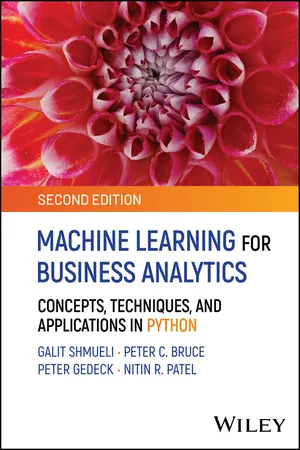
Machine Learning for Business Analytics
Concepts, Techniques, and Applications in Python
- English
- ePUB (mobile friendly)
- Available on iOS & Android
Machine Learning for Business Analytics
Concepts, Techniques, and Applications in Python
About this book
Machine Learning for Business Analytics: Concepts, Techniques, and Applications in Python is a comprehensive introduction to and an overview of the methods that underlie modern AI. This best-selling textbook covers both statistical and machine learning (AI) algorithms for prediction, classification, visualization, dimension reduction, rule mining, recommendations, clustering, text mining, experimentation, network analytics and generative AI. Along with hands-on exercises and real-life case studies, it also discusses managerial and ethical issues for responsible use of machine learning techniques.
This is the second Python edition of Machine Learning for Business Analytics. This edition also includes:
- A new chapter on generative AI (large language models or LLMs, and image generation)
- An expanded chapter on deep learning
- A new chapter on experimental feedback techniques including A/B testing, uplift modeling, and reinforcement learning
- A new chapter on responsible data science
- Updates and new material based on feedback from instructors teaching MBA, Masters in Business Analytics and related programs, undergraduate, diploma and executive courses, and from their students
- A full chapter of cases demonstrating applications for the machine learning techniques
- End-of-chapter exercises with data
- A companion website with more than two dozen data sets, and instructor materials including exercise solutions, slides, and case solutions
This textbook is an ideal resource for upper-level undergraduate and graduate level courses in AI, data science, predictive analytics, and business analytics. It is also an excellent reference for analysts, researchers, and data science practitioners working with quantitative data in management, finance, marketing, operations management, information systems, computer science, and information technology.
Frequently asked questions
- Essential is ideal for learners and professionals who enjoy exploring a wide range of subjects. Access the Essential Library with 800,000+ trusted titles and best-sellers across business, personal growth, and the humanities. Includes unlimited reading time and Standard Read Aloud voice.
- Complete: Perfect for advanced learners and researchers needing full, unrestricted access. Unlock 1.4M+ books across hundreds of subjects, including academic and specialized titles. The Complete Plan also includes advanced features like Premium Read Aloud and Research Assistant.
Please note we cannot support devices running on iOS 13 and Android 7 or earlier. Learn more about using the app.
Information
Table of contents
- Cover
- Table of Contents
- Title Page
- Copyright
- Dedication
- Foreword by Gareth James
- Preface to the Second Python Edition
- Acknowledgments
- PART I: Preliminaries
- PART II: Data Exploration and Dimension Reduction
- PART III: Performance Evaluation
- PART IV: Prediction and Classification Methods
- PART V: Mining Relationships Among Records
- PART VI: Forecasting Time Series
- PART VII: Data Analytics
- PART VIII: Cases
- References
- Index
- End User License Agreement